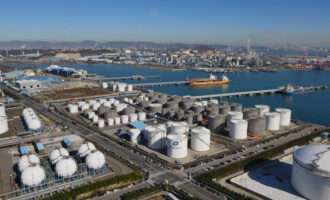
Group III base oils attempt to break into wind turbine market dominated by PAOs
The world’s focus is shifting to environmentally friendly renewable energy sources. The International Energy Agency (IEA) predicts renewable power capacity will expand by 50% between 2019 and 2024, total growth of 1,200 gigawatts (GW). Renewable energy currently accounts for 26% of the world’s energy. IEA expects this share to surpass 30% in the next five years.
A recent report by the International Renewable Energy Agency (IRENA) shows that renewable power comprised 72% of all power expansion in 2019, outstripping fossil fuel growth in the same period. 90% of capacity contributions came from solar and wind as improvements in cost competitiveness enhanced their appeal against new coal and natural gas plants.
While solar continues to provide the bulk of global increases (98 GW in 2019), wind power has enjoyed unprecedented growth over the past few years. Global wind installations jumped from 436 GW in 2015 to 655 GW in 2019. Asia Pacific is a significant driver of this impressive growth due in part to favourable government policies.
In 2019, wind energy capacity expanded by 60 GW, led by growth in China (26 GW) and the United States (9 GW). India is another notable Asian market — now the fourth-largest wind power market behind China, the U.S. and Germany. In the U.S, wind supplied more than 7% of the nation’s energy, making it the country’s largest renewable energy source. A recent report by Global Data expects the global wind power market to grow by 29% over the next decade, approaching USD125 billion by 2030.
Lubrication performs a crucial role in the reliability of a wind farm. Wind turbines are frequently exposed to harsh environments and extremes of temperature, with significant impact on operational costs, downtime and product lifetimes. In 2017, the IEA Wind Technology Collaboration Programme (TCP), the leading international organisation for wind energy research cooperation, estimated around 50% of the current cumulative installed capacity in Europe will reach the end of its operational life by 2030. Severe operating conditions are driving demand for high-performing lubricants to extend the lifetime of wind turbine assets.
Wind turbine gearboxes, imperilled by strong winds at heights of up to 200 metres, are the most common source of failure. Some industry analysts have attributed up to three-quarters of gearbox failures to lubricant degradation. Generators, blades, the main shaft, yaw drive and pitch drives on wind turbines all require consistent, clean lubrication.
Lubricants for the wind turbine market are projected to reach USD226.1 million in 2026 with a compounded annual growth rate (CAGR) of 8%, according to a recent analysis by Reports and Data. In 2018, the market size was USD122.7 million. Some analysts believe Europe will dominate the wind turbine lubricants market in the near term, with a CAGR of 8.9%. Significant lubricant opportunities exist in Asia Pacific due to strong government support and wind power capacity expansion.
Growth in new installations will increase consumption of first fill oils. Oil change frequency, operating capacity and penetration of direct drive wind turbines determine service fill volumes. Stefan Bill, managing director at REWITEC™ GmbH, a company that develops a silicon-based nano- and microparticle surface treatment technology for wind turbines, estimates the market for first fill oils is around 10,000 tonnes, about half that of service fill volumes (20,000 tonnes). The markets for first fill and service fill greases are approximately 600 tonnes and 4,000 tonnes respectively, he says.

Synthetic lubricants fulfil the bulk of the wind turbine industry’s lubricant needs (80%) and are typically polyalphaolefin-based (PAO). With a CAGR of 8.1%, gear oils are expected to be the fastest-growing lubricant type in the near term.
The wind power lubricants market is not an easy market to penetrate, says Mika Kettunen, technical product manager, Base Oils, at Neste Corporation’s Technology Centre. Development timeframes are long due to extensive testing and lengthy field trials; suppliers are well established in this market, he says. However, rapid advancements in the wind power industry has created new opportunities for lubricant companies offering product customisation and strong after-sales service.
A combination of NEXBASE® Group III base oils and VISCOBASE® synthetic base fluid, a new, innovative alkyl methacrylate oligomer, the result of a collaboration between Finland’s Neste Corporation and Germany’s Evonik, is a clear innovation in a market dominated by PAOs. The partnership was formed to provide a cost-effective product, with supply security, that achieves performance previously offered by PAO formulations only, says Kettunen.
Promising test results have demonstrated higher efficiency with reduced traction losses, making maintenance less challenging and reducing maintenance frequency. The technology has excellent solvency and can be formulated with a wide viscosity range, says Kettunen. Approvals from Hansen and FAG/Schaeffler for wind applications and Siemens for Flender gear units have been achieved, and the product is currently undergoing field trials in Europe and the U.S.
Partnerships will continue to be integral to wider solutions for the wind turbine lubricants industry, says Kettunen. They will also allow regional players to be more competitive, he says.
REWITEC is another company providing innovative solutions to improve the efficiency and longevity of wind turbines. Founded in 2003, REWITEC was acquired by global speciality chemical manufacturer Croda in July 2019.
REWITEC’S additive technology uses lubricants as a carrier of silicon coating particles, which build a protective and repairing layer on the surface of tribological systems to reduce wear, friction, surface roughness and temperature. The patented nano- and microparticle technology can limit, restore and correct surfaces degraded by excessive wear and corrosion and can extend the lifetime of wind turbine operations beyond 20 years, says Bill. Reductions in friction and surface roughness of 30-55% have been observed in research completed at the University of Mannheim and Giessen, which was supported by the German government.
 The outlook seems promising for wind turbine lubricant manufacturers, though, several factors could hinder the long-term growth prospects of the market — such as withdrawal of government support in individual countries and scarcity of land for onshore installations. Operators are demanding more robust lubricants in conjunction with a shift to larger turbines with higher capacity factors, and a trend to offshore and floating turbines poses greater challenges around moisture and corrosion.
The outlook seems promising for wind turbine lubricant manufacturers, though, several factors could hinder the long-term growth prospects of the market — such as withdrawal of government support in individual countries and scarcity of land for onshore installations. Operators are demanding more robust lubricants in conjunction with a shift to larger turbines with higher capacity factors, and a trend to offshore and floating turbines poses greater challenges around moisture and corrosion.
An anticipated increase in average drain intervals, from five to 10 years, is likely to impact market volumes moving forward. Though, 15-20% growth of the market and larger oil volumes in wind turbines will compensate this negative trend a little, says Bill. Total volumes may stagnate in the future, he says. Alongside longer drain intervals, Kettunen emphasises the rising importance of online and condition monitoring of lubricants so companies can accurately predict maintenance needs.
Advances in gearless technology pose a further threat to lubricant volumes. Direct drive wind turbines do not have a gearbox, instead opting for a low-speed, permanent magnet generator. With gear oils accounting for 70% of lubricant volumes, a sharp ramp-up in direct-drive technology could have a profound impact on lubricant consumption in this market segment.
An increase in direct-drive turbines is anticipated over time, though Bill suggests the technology will stay below 20% market share (currently 10%) in the foreseeable future, with gear-driven turbines remaining the dominant technology. Direct drive technology is considerably higher in cost and higher in weight — therefore increasing the cost of installation. Also, failures in existing gearbox technology are declining with improving equipment performance and lubrication quality.







